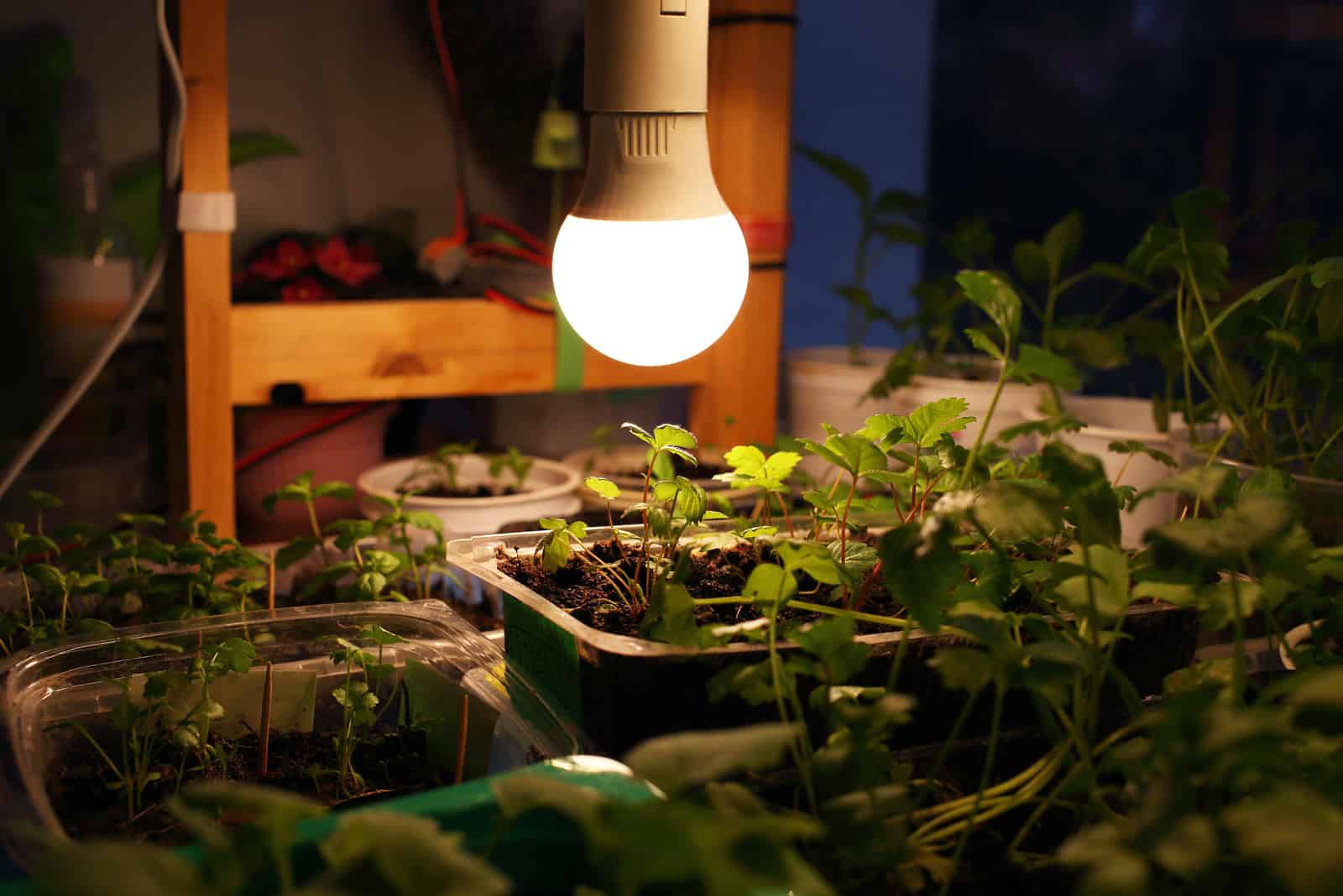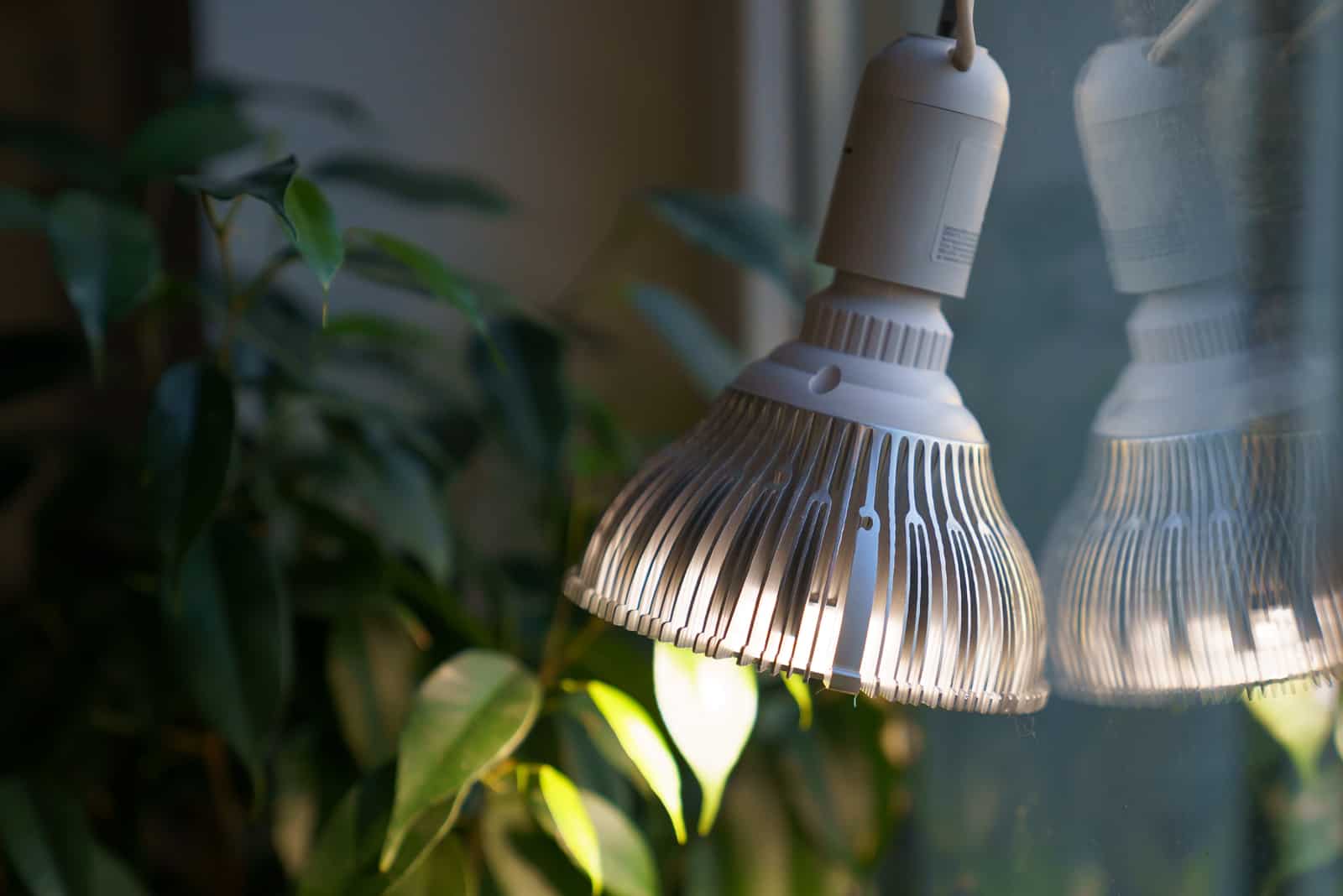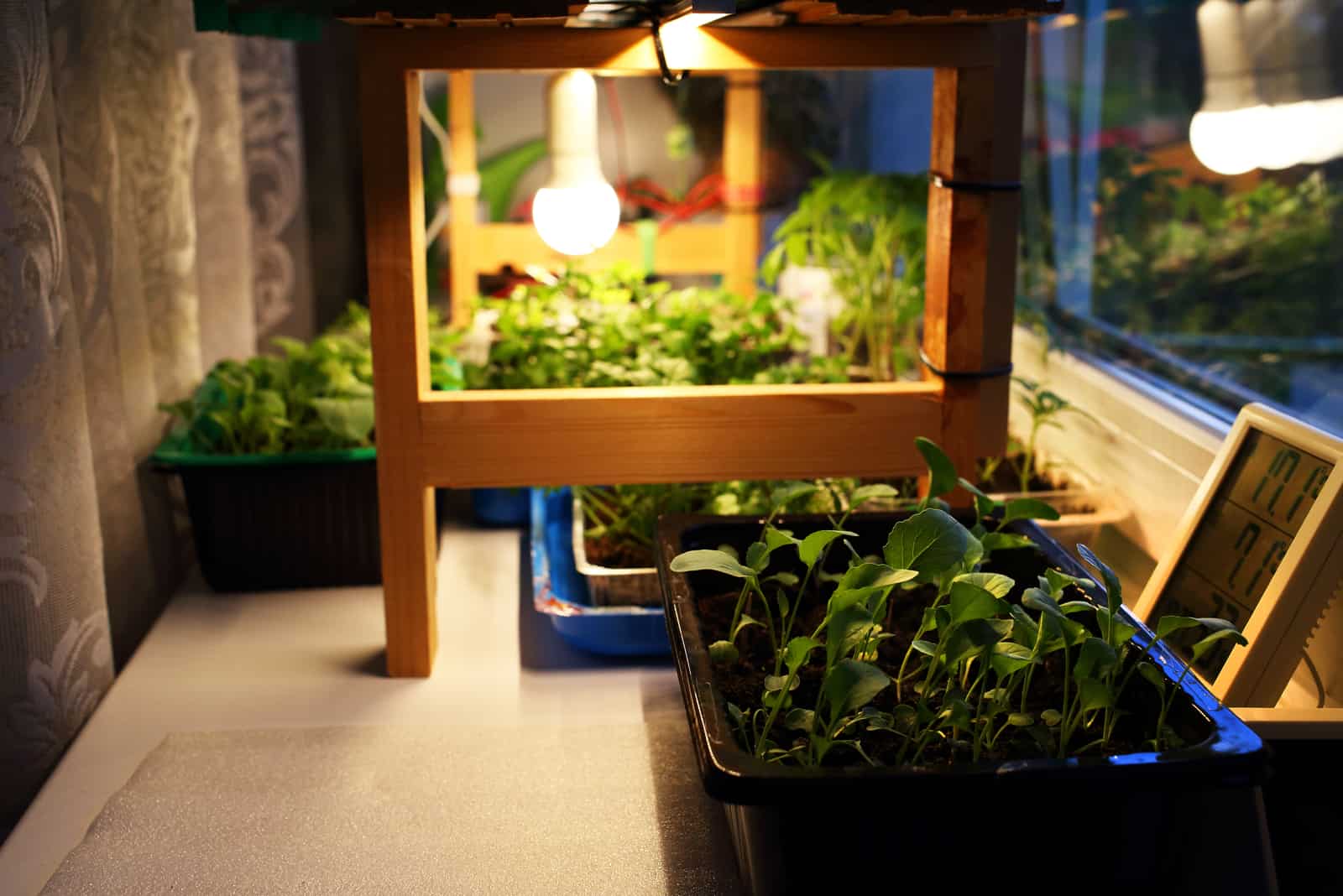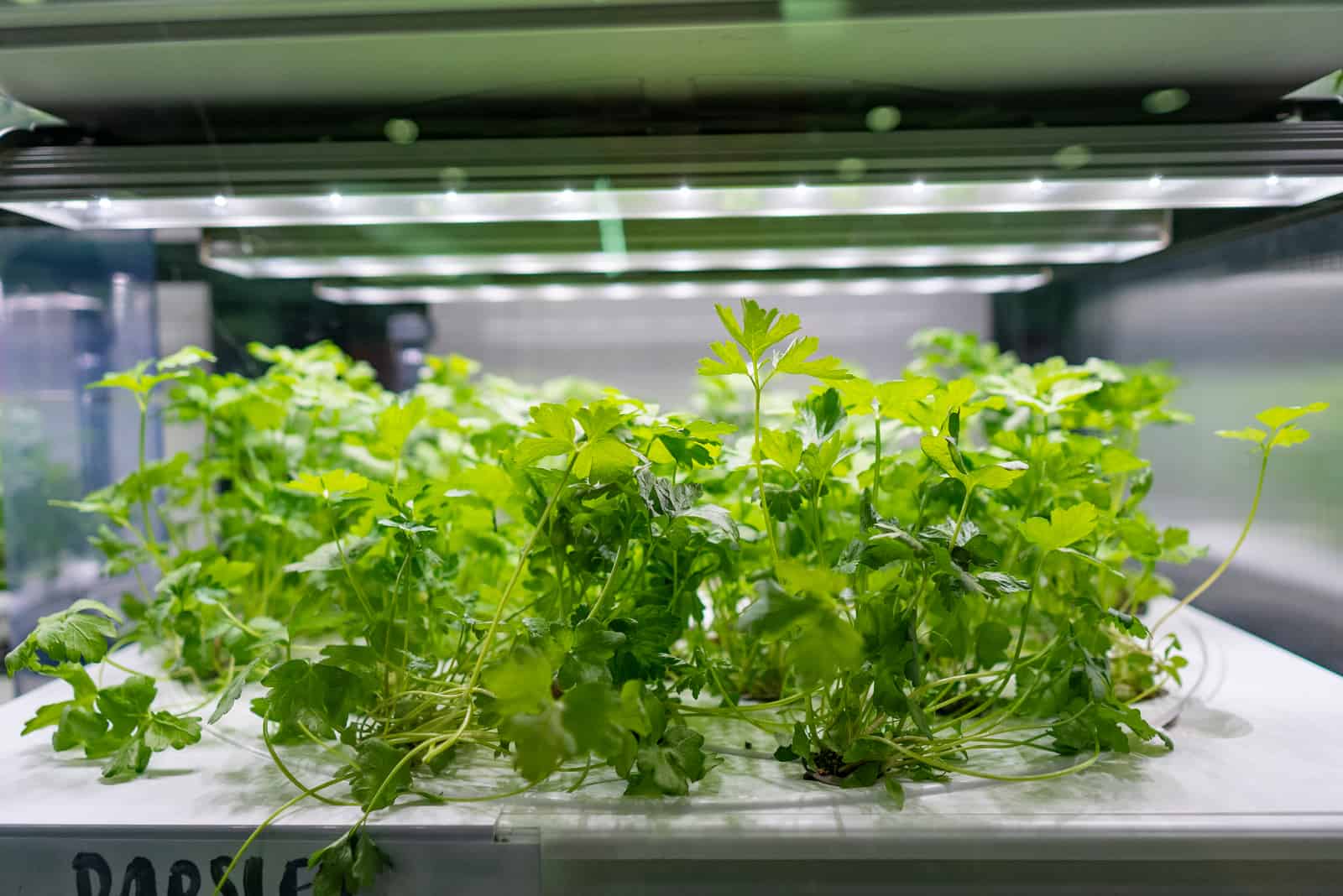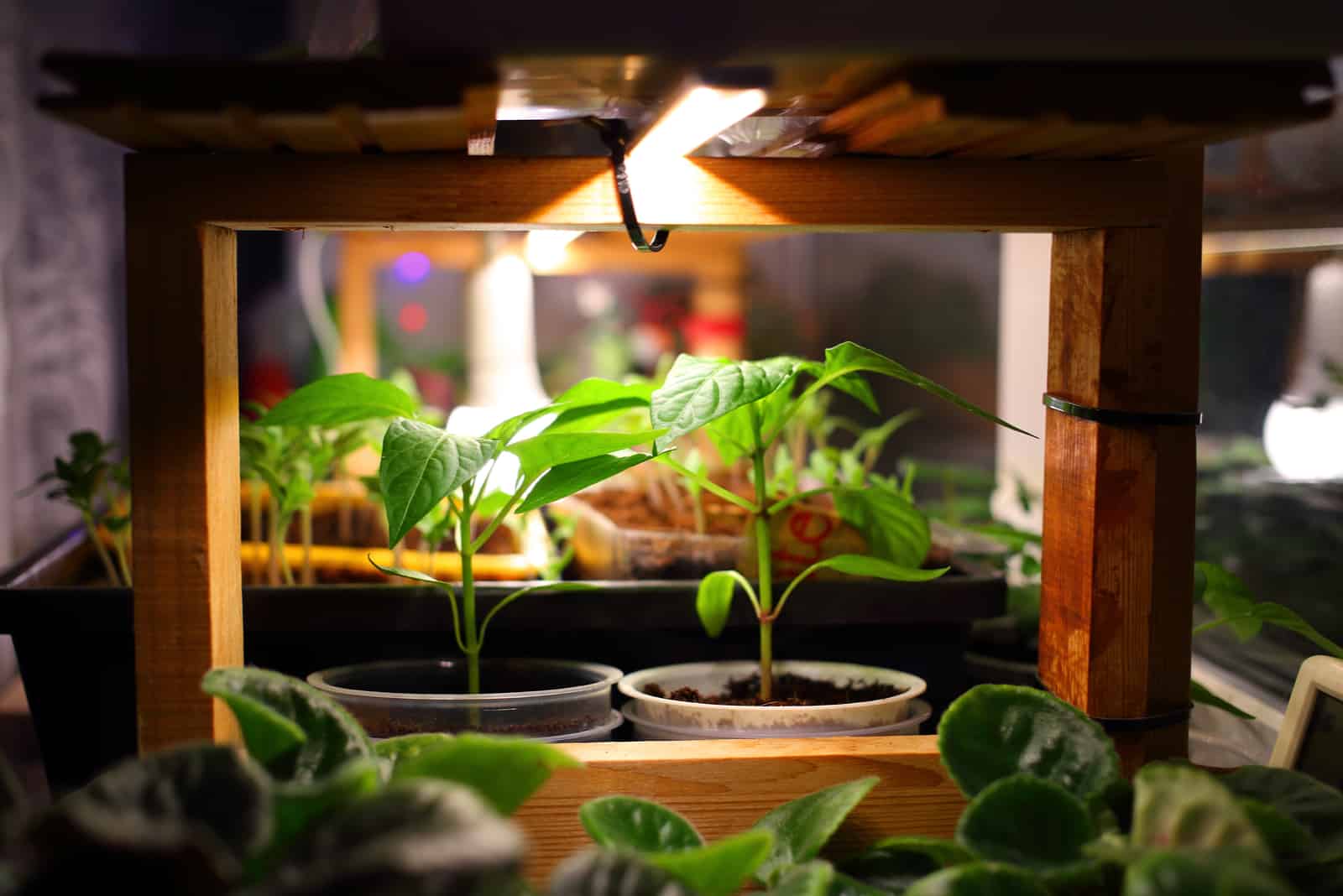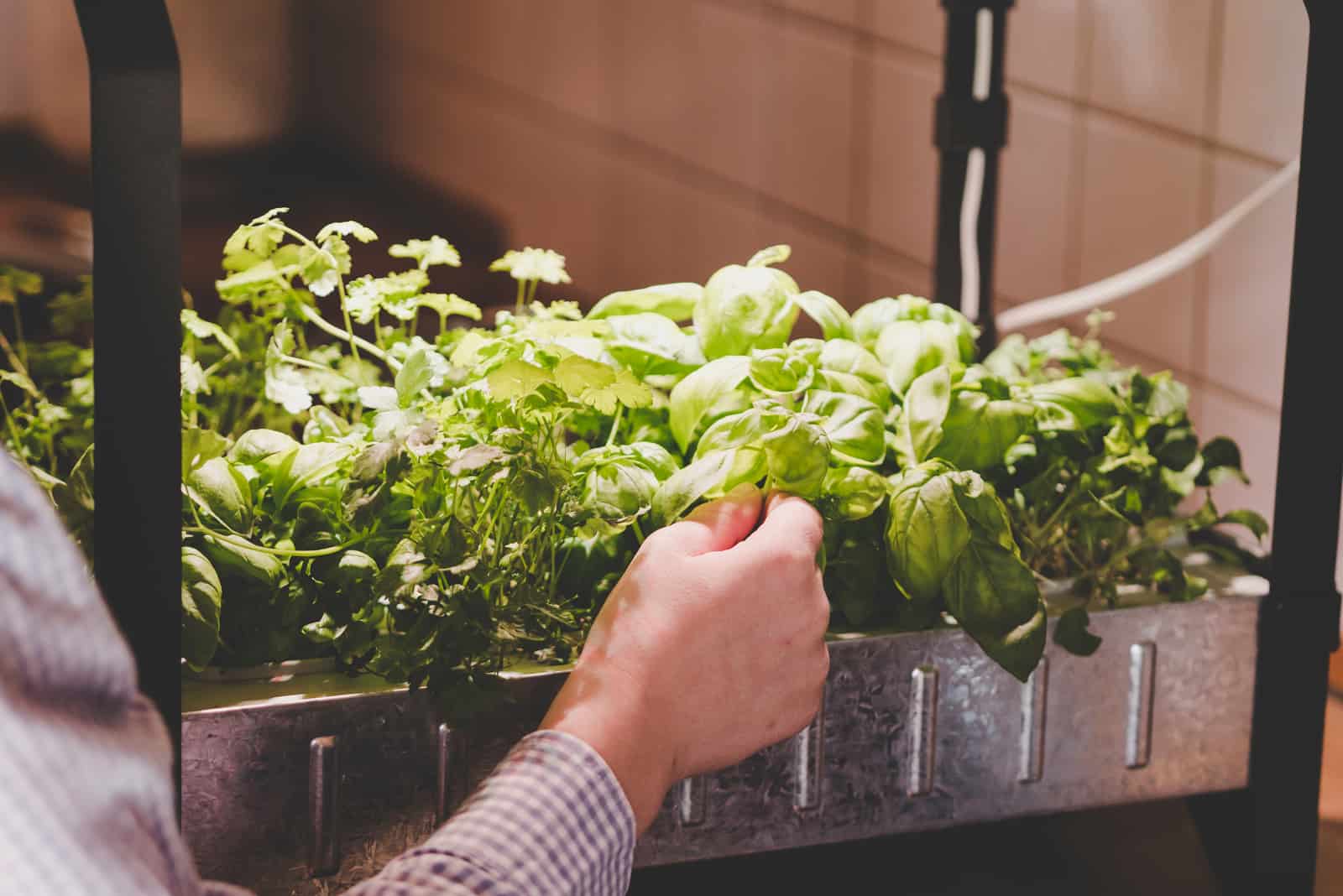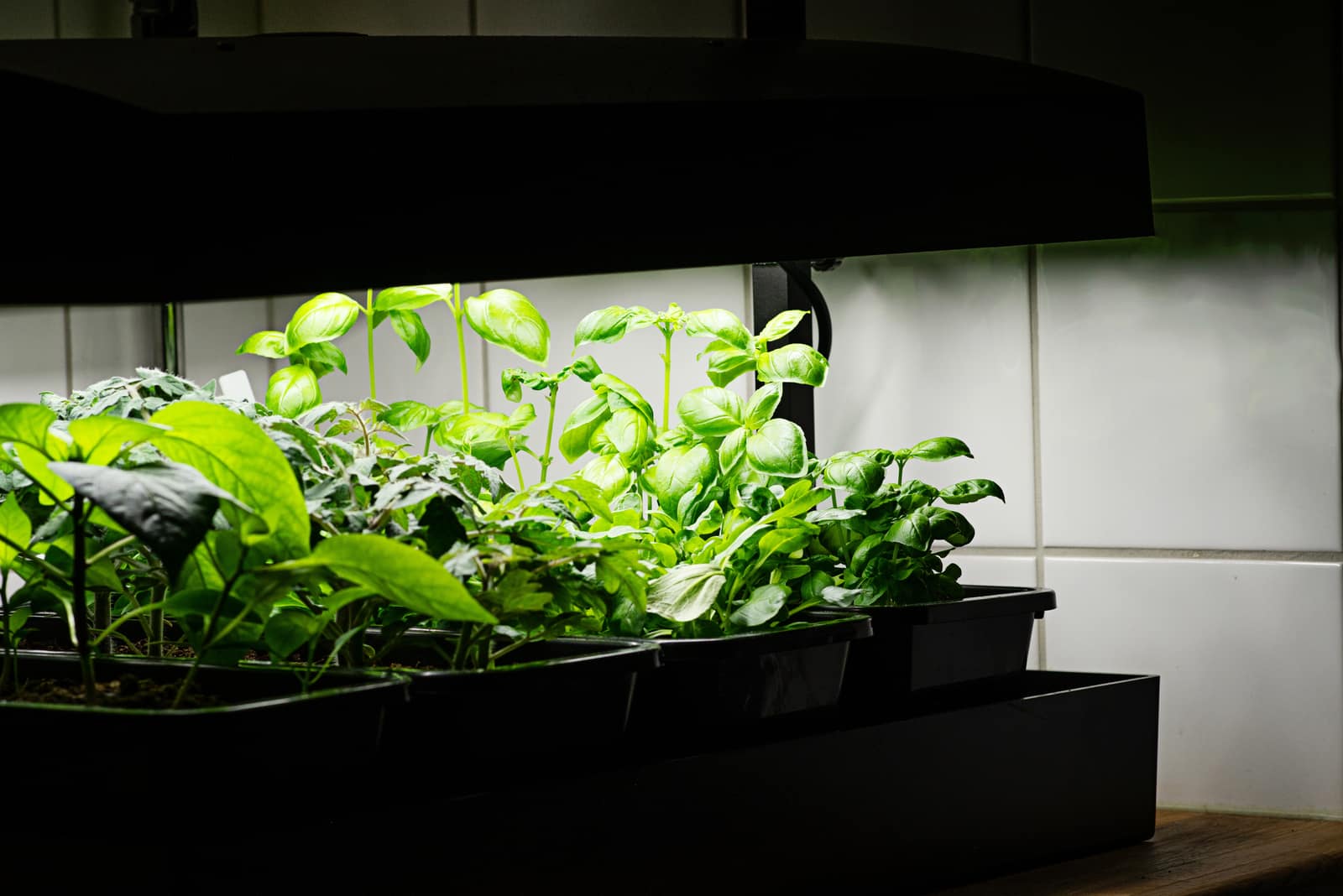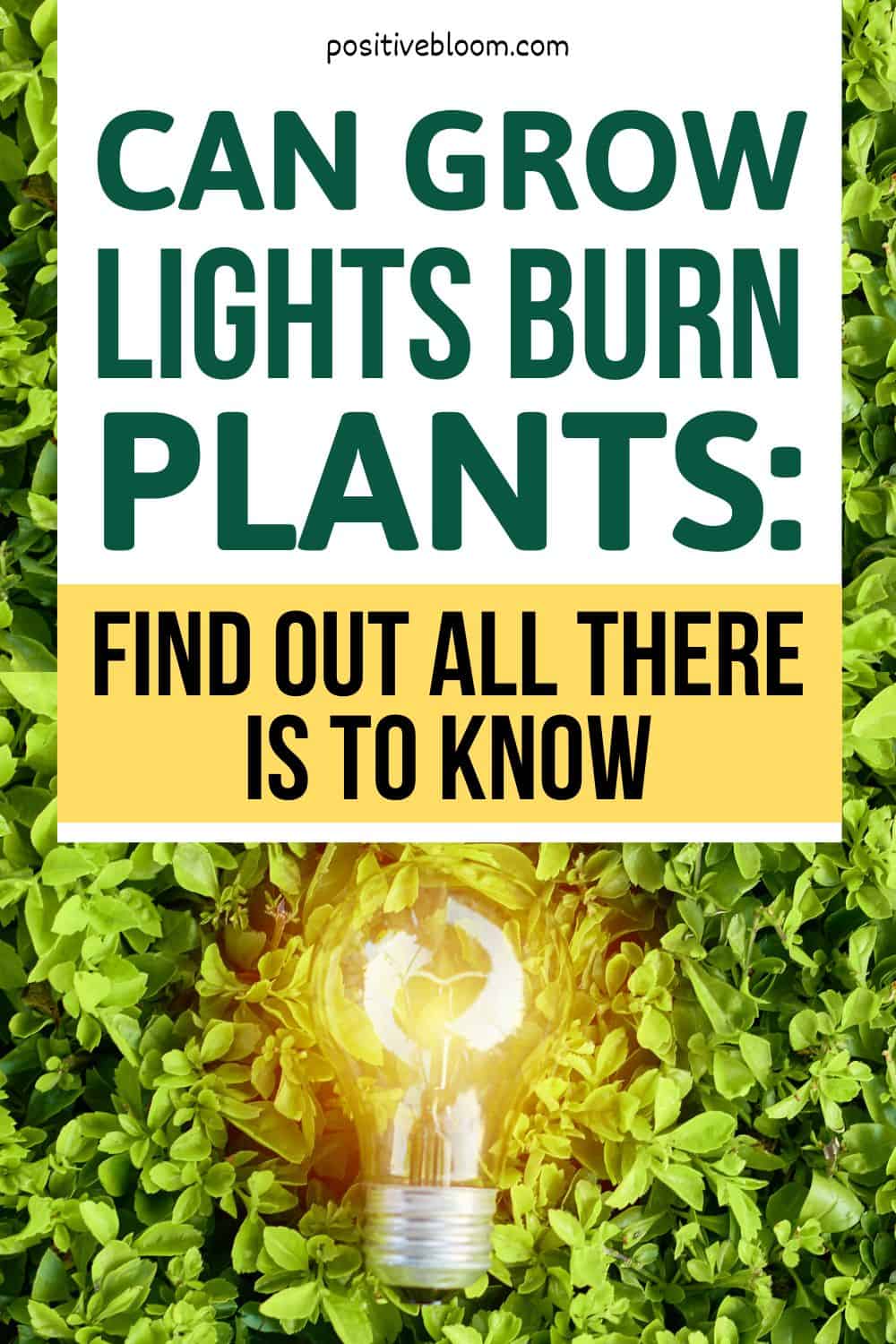Positive Bloom is an Amazon Associate and we earn from qualifying purchases through these links at no extra cost to you.
Plants need a fair amount of light in order to thrive, but what happens when they don’t get enough from nature?
That’s when plant lights come into play, and those little light bulbs start working round the clock! But can grow lights burn plants?
We’ve heard this question a lot, so we decided to share some knowledge and secrets of safely growing plants under grow lights.
Let’s find out more!
Can Grow Lights Burn Plants?
Unfortunately, grow lights can hurt and burn your plants. However, it isn’t the amount of light that’s the problem, but rather the heat that the lights emit.
Indoor plants kept too close to light bulbs can experience bleaching of their leaves and even burns if the heat is too intense.
Remember to keep an eye on your plants and lights, and if you notice anything strange going on you should move the plants further away from the lights immediately.
On the other hand, if your plants don’t seem to get enough light you can always move them closer to your artificial lights.
For instance, the care guide of the echeveria flower says that it requires full sun not to grow leggy, and if that isn’t impossible in the climate you live in, you can always use grow lights to help you out.
Why Do Plants Need Grow Lights?
Plants don’t necessarily need grow lights, but they do require a source of light that can fulfill all their needs.
Light is essential for photosynthesis, without which plants cannot produce the food and energy they need to grow and develop.
Plants require plenty of light during their vegetative phase, which is when they photosynthesize to produce and store the sustenance and resources they will use once they start flowering and fruiting.
3 Signs Your Plant Requires More Light
Thankfully, your plant will let you know if it needs more light, so you don’t have to worry about whether you’re meeting your plant’s needs.
You can’t just suddenly move your plant into direct sunlight or under intense grow lights and expect everything to be hunky-dory; you need to gradually introduce your plants to more light in order to avoid severe sunburn.
Below, you will find three signs that your plant needs more light, and only when you notice them should you move your place to a sunnier spot or under grow lights.
1. Faded Foliage
Fading of the leaves and a loss of color is common when your plant isn’t getting enough sunlight. Prolonged exposure to low-light conditions makes it difficult for plants to synthesize chlorophyll, and it’s the chlorophyll that makes your plant’s leaves green.
A lack of chlorophyll means no photosynthesis, and no photosynthesis means no energy or food. Therefore, your plant’s foliage may not only fade, but turn yellow as well.
Older, yellowed leaves tend to drop off as your plant needs all the energy it can get.
2. Variegation Loss
Another thing that indicates your plant isn’t getting the proper amount of light is a loss of variegation. For instance, variegation can help us distinguish between philodendron White Wizard and White Knight and allow us to admire their beauty.
However, if these or any other variegated plants are exposed to shade for too long, the leaves may turn completely green – and not even propagation can save them in this case.
Plants don’t do this out of spite, they turn green in order to survive because green leaves mean more of the chlorophyll necessary for energy production.
Generally speaking, variegated plants require more light than your every-day houseplants because their leaves contain less chlorophyll.
3. Legginess
Finally, your plant will definitely grow leggy when grown in low-light levels. Legginess refers to the elongation of the stems, and it can be quite unsightly and harmful to your plant.
Legginess won’t kill your plant, but the long stems will droop because the stems aren’t strong enough to carry their weight. They may also drain your plant of its energy and make it weaker.
But why does a plant grow larger if it doesn’t have enough light?
Well, plants always grow towards the light, and when they don’t get enough of it they elongate their stems in search of it.
Unfortunately, they don’t always find a suitable light source, which is why you should get grow lights to help your plant grow strong if you notice legginess.
What Are The Different Kinds Of Grow Lights?
There are many grow lights and heat lamps made for plants, but not all of them are the same.
Some dissipate a lot of heat and have varying light intensity levels, while others have wavelengths your plants simply adore.
The following section will discuss four different types of lights and their pros and cons, so you can decide which is the best option for your plants.
LED Grow Lights
LED lights, or light-emitting diodes, usually have a low wattage, which makes them an ideal cost and energy-efficient choice. They also stay cool even after working for long hours and emit less heat, which makes them a safer and burn-free option.
Unlike other lights, full-spectrum LED lights have a wide range of colors, which means they can mimic natural sunlight and come in either full-spectrum or as a red and blue light. A good thing about these lights is that you can adjust the color specifically for your plant to speed up its growth at different stages of its life cycle.
You can get these lights in different shapes and sizes depending on your needs. There are some great LED bulbs, strips, standalone, and hanging lamps, but these are the ones we recommend:
[lasso id=”2474″ link_id=”6511″ ref=”amzn-leoter-grow-light-for-indoor-plants-upgraded-version-80-led-lamps-with-full-spectrum-red-blue-spectrum-3-9-12h-timer-10-dimmable-level-adjustable-gooseneck3-switch-modes”]
Fluorescent Lights
Fluorescent lights are the next best thing. They don’t give off as much heat as some other lights on the market, they last longer, and use much less energy than incandescent lights.
One of the advantages of fluorescent bulbs is that there are many different sizes available, so you can easily find one that fits your light fixture.
Compact fluorescent lights are always full-spectrum, but you can find ones with more blue or red lights depending on whether your plant needs cooler or warmer tones. This is the one we recommend:
[lasso id=”7638″ link_id=”6512″ ref=”amzn-hydro-planet-t5-grow-lights-4-feet-4-bulbs-fixture-with-fluorescent-ho-bulbs-6500k-indoor-plant-lights-plant-grow-light”]
Incandescent Lights
Incandescent bulbs are the regular bulbs you see in stores and that you probably already own. Growers around the world use them if they don’t have too many plants; simply put them in a trendy lamp and you’ve got yourself some DIY grow lights!
These are the light bulbs we use to light our home and porch, and sometimes our plants in times of dire need:
[lasso id=”7639″ link_id=”6513″ ref=”amzn-a19-frosted-incandescent-rough-service-light-bulb-60-watt-2700k-soft-white-e26-medium-base-550-lumens-130v-6-pack”]
However, they do produce a fair amount of heat, which doesn’t make them the best option for your plants.
Another downside of these lights is that they use a lot of energy, and because grow lights are on for most of the day they can get quite pricey.
HID Lights
HID, or high-intensity discharge lamps, are usually used in commercial growing. There are two types of HID lights: metal halide and high-pressure sodium.
The only difference between the two lamps is the type of gas they use. Unlike LED lights, HID lights cannot be adjusted, so it’s important to research your plant needs beforehand and choose HID lights based on whether your plant prefers red or blue light.
Metal halide emits a cool, white light, while high-pressure sodium gives off an orange-white light.
If you need some metal halide bulbs for your hydroponics, you should try these:
[lasso id=”7640″ link_id=”6514″ ref=”amzn-ipower-glbulbm600-a-grow-light-bulb-metal-halide-mh-conversion-lamp-for-plants-high-par-enhanced-blue-violet-spectrums-cct-6000k-600w”]
HID lights look like giant reflectors, so they’re not the best choice for a grow room due to their size and cost.
Many gardeners still use them for their intense light when growing hydroponics or anything for commercial purposes.
How Close Should You Place Grow Lights To Plants?
The distance between your plants and grow lights depends on the heat the lights give off. For instance, LED lights should be placed 12-18 inches away from the plant in order to not burn it.
On the other hand, fluorescent lights don’t need to be placed further than 6-10 inches away from seedlings as they don’t emit too much heat.
However, incandescent light can get really hot, so you should move your plants a bit further away, but no farther than approximately 30 inches.
Finally, HID lights are quite strong, and you should keep them at least 1 foot away from your plants.
These measures are general, and you should always account for the wattage of your lamps. The higher the wattage, the further away the light should be.
For example, if your HID lights are 1000W, you should space them at least 15 inches away from your plant.
How To Choose The Best Light For Your Plant
If you want to give your succulents, cannabis, or any other type of plant perfect growth conditions, there are some things you need to take into account when buying grow lights.
When we were beginners, we didn’t think much about different color spectrums and how they might contribute to plant growth.
However, different colors speed up your plant’s development at various stages, and what might induce germination might not work in the flowering stage.
There are other things you need to consider when choosing artificial lights, such as heat emission, lit surface, and the amount of time you’ll be using the lamp.
Think Of The Color Spectrum
Different color spectrums of light benefit your plants in different ways, and lamps can be distinguished by the color they emit.
There are full-spectrum white lights and red and blue spectrum lights. Full-spectrum tend to imitate natural sunlight, which is why they can also give off some UV and far-red light, which play an interesting role in plant development.
Full-Spectrum White Light
Full-spectrum lights range from 400 to 800 nm, which means they have red and blue lights as well as some other colored lights.
It makes them a good choice if you’re not a fan of red or blue, but it also has some additional benefits.
Full-spectrum lights may sometimes contain UV lights, which induce the production of anthocyanins and terpenes. These compounds add to the overall aroma and flavor of your plants, and can also make the colors more vivid.
On the other side of the spectrum, we have far-red light, which is proven to enhance leaf size and plant growth. It also contributes to photosynthesis, and if you compare plants that have been under far-red light to those which haven’t, you’ll notice a difference in earlier flowering and increased growth.
Red And Blue Light
The red and blue spectrum ranges from 400-700 nm and encompasses what we call “visible light”. It is essential for plants because they use this light for photosynthesis.
Red light is vital for plant growth, flowering, and fruiting. It helps with the establishment of young plants due to its significance in generating biomass.
However, using red light alone won’t do your plants much good, and even though they will develop rapidly they could also become elongated and fragile.
On the other hand, blue light is linked to the synthesis of chlorophyll, which makes your plant strong and healthy. It is also responsible for the coloring of your plants, so you can forget about faded and yellow leaves.
Consider Heat Dissipation
Another thing that you should be on the lookout for is heat dissipation. Look for bulbs and lights that don’t emit too much heat because they are generally safer for your plants.
However, heat dissipation can also help you decide where to place your plants. If the light bulb gives off immense heat, you should move your green buddy a few feet away, which immediately lowers the amount of light it’s getting.
On the other hand, lights that get really hot use a lot of energy, which makes them more expensive in the long run.
Don’t Forget About The Lit Surface
Always take how many plants you want to light with your lamp into consideration. There are lights ideal for a single plant and hanging lights that can give light to many.
Larger lamps with more bulbs tend to be more expensive and use more energy, so don’t waste your money on them if you only have one plant that requires more light.
This is the light my mom uses for growing basil indoors, and let me tell you: I haven’t had pasta without basil ever since my mom got this lamp!
[lasso id=”7641″ link_id=”6515″ ref=”amzn-growled-led-umbrella-plant-grow-light-herb-garden-height-adjustable-automatic-timer-ul-adapter-included-ideal-for-plant-grow-novice-or-enthusiasts-various-plants-diy-decoration-white”]
Bear In Mind The Time Of Use
Finally, don’t forget how much time you’ll be using your grow lights. There are lamps that come with intelligent timing functions, so you don’t have to get up in the middle of the night to turn them off.
Also, different plants require different amounts of light each day. There are plants that need more than 16 hours of light each day, and there are others that will do just fine with 10.
Indoor gardening is a science, and you will need to make many adjustments and compromises to achieve your ultimate goal. However, energy-efficient grow lights can get you a long way and help you avoid fainting every time you get your electricity bill!
How Much Light Do Plants Need?
Not all plants require the same amount of light each day. There are short-day plants that can do perfectly well with 10-12 hours of sunlight per day. These plants are fastidious about their light exposure, and if the days (or rather the amount of light) are longer than 12 hours, they won’t produce their gorgeous blooms.
The most common short-day plants are chrysanthemum, Christmas cactus, and violets.
However, there are also plants like succulents that adore sunlight and need more than 12 hours to produce flowers and fruits. Those plants are known as long-day plants and usually need about 16 hours of light each day.
Some of our favorite long-day plants include potatoes, lettuce, and spinach.
Finally, there are also plants called day-neutral that flourish regardless of how long the day is, and our favorites include tomatoes and cucumbers. However, during the tomato seedling stage, you should use grow lights to make them germinate and develop faster.
How Do You Know If A Plant Is Getting Too Much Light?
Plants can sometimes get too much light. The most common sign that your plant has been exposed to excessive amounts of light are sunburns.
The mesmerizing leaves of your houseplants will turn brown or yellow when they burn, and can even become crispy. There’s a thing called “photo-bleaching”, where your plant’s leaves turn pale due to excessive light exposure.
Excessive light will dry out the soil and water loss can lead to drooping and wilting. This is why you should always research your plant’s needs; it’s always better to prevent an issue than deal with it later.
Common Questions
We have answered most of the critical questions about grow lights, but there are still a few things that require our attention.
We looked through your most common questions about plant lights and picked the two best.
Let’s take a look!
Can you burn plants with LED grow lights?
Even though LED lights are the safest for your plants, they can still hurt them and even burn their leaves if they’re too close.
LED lights can even cause photo-bleaching in plants that don’t need plenty of light throughout the day.
Can grow lights be used outside?
Yes, you can use grow lights outside; just make sure you find a waterproof variety that the rain won’t damage.
You can even use them in greenhouses and grow tents to help your plants flourish.
Summing Up
We wanted to answer the question: “Can grow lights burn plants?”. We also learned some facts about artificial lights, and whether they are safe and actually work.
There are four varieties of grow lights, and they all have different characteristics. Some factors can help you decide which one to get, and we examined them all in detail.
We also discussed the most common signs that your plant needs more light, such as legginess, loss of variegations, and fading of the leaves.
However, different plants have different light preferences, so always consult a care guide for each specific plant to see how much light it actually needs.
Have fun with your indoor garden, and until next time!
Like this post? Share or pin it for later!

